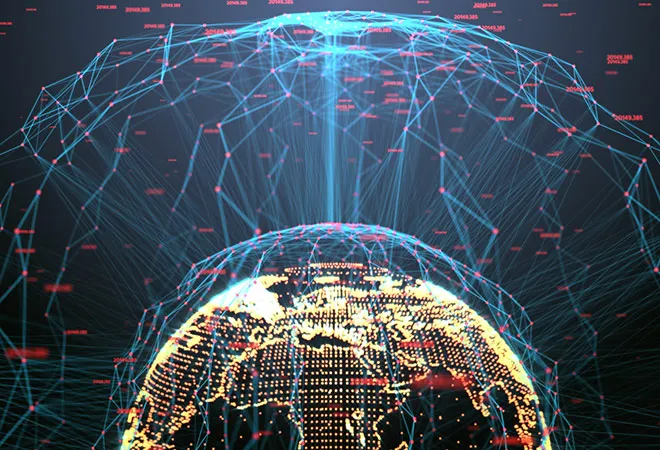
The Artic, Eurasia and the Indo-Pacific have traditionally been treated as separate and distinct entities in the realm of diplomacy. However, their shared maritime geography, coupled with the economic and strategic drivers of this century are advancing a convergence of these three areas. While there is a possibility that this region will emerge as an arena for economic, military, and political competition, there is also a recognition of its potential to be an avenue for cooperation and collaboration. Thus, we may see the emergence of new power structures that can directly compete with the Atlantic system in serving as the centre of economic, military, and political dominance.
The Arctic, known as the world’s “last frontier”, is undergoing rapid changes as a result of anthropogenic climate change and global warming. Currently covered by sea ice, the Arctic is different from the Antarctic and it has no landmass underneath. Accordingly, its legal regime for governance, and its role in the future of geopolitics will also be different. Nation states recognise that the region’s value lies in the new areas it can open up for navigation, trade, and resource exploration.
Russia currently posits itself as an Arctic superpower, backed by the support of its naval and submarine fleet. Given the natural prolongation of its continental shelf, Russia has made expansive claims of sovereignty over natural resources on the Arctic seafloor. China, for its part, considers itself to be a “future” Arctic superpower, and has been working on a polar strategy along with its Belt and Road Initiative (BRI). China’s polar strategy comprises of three pillars, viz: security, natural resources, and scientific research. On the future, we may see cooperation between China and Russia in regards to the Arctic. This is seen in their recent agreement to develop the Yamal LNG (Liquefied Natural Gas) pipeline, which is touted to be the biggest natural gas project in the Arctic Circle. While it is easy to see military and strategic overtures in the Arctic, one must not miss out on potential areas for cooperation in the field of fisheries, migration, scientific research and climate change mitigation.
As we discuss connectivity in the region, China’s BRI comes to the forefront of all discussions. Launched in 2013, China’s massive development strategy involves projects and investments in all of Europe, Asia and Africa. While infrastructure can bring countries together, it can also create faultlines when global actors have divergent visions for regional integration and connectivity. China’s vision for the BRI appears to be fuelled by its intention to establish a Confucian-inspired global hierarchy with itself as the key global actor. Distinct from the traditional framework of the Westphalian order, this structure sees China as the responsible and benevolent father figure at the centre.
However, various countries have voiced suspicion—even hostility—towards the BRI project. While China’s offers under the BRI are attractive, there appear to be various monetary and non-monetary costs associated with it. China is yet to clarify issues regarding rules and norms governing the project, and assuage concerns surrounding transparency and corruption. This is where other emerging countries, like India, could play a leading role in ensuring that China adheres to the rule of law. China must recognise that no country can be an island, and national interests of every country is inevitably intertwined with those of others.
Moving to Eurasia, there is a need to define and recognise what Eurasia comprises of: is it the vast landmass covering all Europe in the West, the Indian subcontinent in the South, and Asia in the East? Or does it specifically refer to deeper engagement with Russia and Central Asia? Presently, the Central Asian Republics, lying at the heart of the continent, are experiencing a rebirth. Central Asia comprises of former Soviet Republics: Kazakhstan, Kyrgyzstan, Tajikistan, Turkmenistan, and Uzbekistan. These countries have been plagued by a host of common issues due to their autocratic structures, poor human rights record and corruption. This is the primary reason why Atlantic states have overlooked them as an area for diplomatic engagement, cooperation, and investment. However, Russia and China have been indicating their interest to engage with the region for security, resource exploration, and infrastructure development. Given the instability in the region, there is a need for massive investment of resources, personnel, and political capital. As we see a convergence between Eurasia, Arctic, and the Indo-Pacific, Central Asian countries will form an important component of this engagement.
The Eurasian convergence will also be incomplete without the involvement of previously neglected areas of Europe. China has been the most recent country to give them a bigger, geopolitical presence. One way in which China has being doing this through the is the Belt and Road Initiative, The second way, is the 16+1 mechanism which is a platform for cooperation between China and 16 Central and Eastern European Countries (CEEC). The mechanism is envisioned to enable greater engagement between China and these countries in investment, infrastructure and transport, finance, science and technology, education and culture.
Conceived in the mid-2000s, the idea of the “Indo-Pacific” aimed for the integration of the Indian Ocean and the Western Pacific regions. Beginning from Eastern Africa, traversing through East and South Asia, and encompassing South China Sea, Japan, Indonesia and Australia, the Indo-Pacific region is an area for contest between the world’s major powers. Given the diverse and enormous nature of the region, it is crucial to recognise the role institutions can play in maintaining peace, stability and security. The Association of Southeast Asian Nations (ASEAN) has often been overlooked as a key stakeholder in the region. The ASEAN countries were initially considered as the “Balkans of Asia”, but have now grown into a viable regional conglomeration. Another important inter-governmental forum is the Quad countries (Australia, Japan, India and the US), but they are yet to come into their own to play a significant role vis-à-vis the Indo-Pacific. Originally viewed as a containment strategy for China, the return of the Quadrilateral Security Dialogue (QSD) indicates the establishment of more cohesive strategy for collaboration in this region.
Old institutions, and perhaps the establishment of new ones, can be a way to diffuse tensions and seamlessly connect the two arteries within the heartland. Institutions not only provide a platform for cooperation and engagement, but can also help create checks and balances for its member states. The importance of a multi-track diplomacy involving individuals, institutions, and communities through dialogue, conflict resolution, confidence building measures, and peace building, can help create a peaceful neighbourhood. India must find ways to resolve its own paradoxical approach to the region, from its erstwhile neutral stance to its current path of emerging as a balancing power.
In recognising the reorder of present power structures, “uncertainty” has arisen as a common theme of current time. In this context, we need a sustainable and effective global system that is not only preserving the norm and institutions we have today, but also making them acceptable and relevant for all actors in the world.
The views expressed above belong to the author(s). ORF research and analyses now available on Telegram! Click here to access our curated content — blogs, longforms and interviews.




 PREV
PREV


